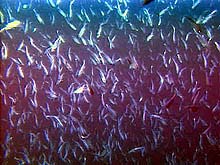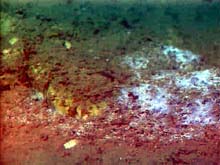On this muddy substrate at about 500 m depth, amid occasional patches of cobble and boulders, sits a black crinoid. Most of the crinoids encountered in this area are lighter in color. Click image for larger view.
While descending toward the bottom, ROPOS encountered a dense school of myctophids (lantern fish) at 250 m depth. The fish seemed to be attracted to the lights of the submersible and followed the ROV for a short time. Click image for larger view.
The whitish area at right is a patch of bacterial mat, which are often found in methane seep areas. The bacteria thrive off gases that seep up through the sediment. Click image for larger view.
Clams were spotted at a seep area 500 m deep. They use the methane or hydrogen sulfide that seeps up through the sediments for chemosynthetic processes. Click image for larger view.
Comparing Underwater Realms: Exploring
the Habitats of Heceta Bank
July 4 – July 13, 2001
(Phase 3 of the Expedition)
July 4, 2001
Susan Merle, Geological Research Assistant
Cooperative Institute for Marine Resource Studies Program, Oregon State University
Vents Program, Pacific Marine Environmental Laboratory, NOAA
and
Curt Whitmire
Cooperative Institute for Marine Resource
Studies
Oregon State University
On July 3, a 25-member science crew aboard the NOAA Ship Ronald H. Brown embarked from Astoria, Oregon, to study the habitats of invertebrates and commercially important species of groundfish on Heceta Bank. This leg of the expedition, Phase 3, follows the NOAA expedition to Astoria Canyon, and will complete the Lewis and Clark Legacy Expedition. During our port call at Astoria, 15 members of the science crew from the Astoria Canyon cruise disembarked, while 8 new members remained to join us on the Heceta Bank cruise.
This science crew consists of a diverse group of researchers from governmental agencies, universities, conservation organizations, the Hatfield Marine Science Center, and the Natural History Museum of Los Angeles County, California. The cruise is part of a continuing study of habitat-based fisheries research on Heceta Bank that began in 1988, and a follow-up to our cruise here during the summer of 2000. Additionally, we hope to compare data from this cruise with data collected during our explorations of Astoria Canyon, in order to provide insights as to the extent of human impacts on these two marine ecosystems.
The ship arrived on station about 30 mi off the central Oregon coast early on the morning of July 4. Operations with the remotely operated vehicle (ROV) ROPOS began around 7:40 am PST. The target for this particular dive was known to be a primary spawning ground for Petrale sole at approximately 500 m water depth. During the descent, ROPOS passed through dense schools of myctophiids (lantern fish), which seemed to be attracted to the lights of the submersible, at about 250 m.
At the bottom, the ROV's lights illuminated a sea-floor characterized by patches of cobbles and boulders scattered on slopes of mud. Some of the groundfish that came into view on our video monitors included thornyheads (Sebastolobus), Dover sole, and sablefish, while some of the representative invertebrates included a black crinoid, some brittlestars, and sea stars. We observed an interesting behavioral trait when a school of sablefish dove down into the mud substratum, presumably feeding on small krill (tiny relatives of shrimp) in the sediment.
Toward the end of the dive, ROPOS encountered a small seep habitat, which often occurs when methane or hydrogen sulfide gas seeps up through the sediments from below the sea floor. Some unusual organisms thrive in these rare environments, including bivalves (primarily clams) and bacteria that form whitish mats on the sediment. ROPOS sampled many of these clams, and attempted to sample the seep gases with a Niskin bottle. The dive ended at 12 noon PST. The ROV is back in the water again. Watch for an update tomorrow.
Sign up for the Ocean Explorer E-mail Update List.

































